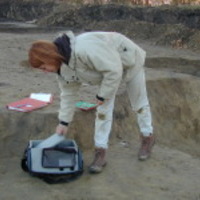
Robert J Hoard
1
Address: Topeka, KS 66604
USA
Address: Topeka, KS 66604
USA
less
Related Authors
Michael Boyd
University of Cambridge
Juan Antonio Quirós Castillo
University of the Basque Country, Euskal Herriko Unibertsitatea
Philipp Wolfgang Stockhammer
Ludwig-Maximilians-Universität München
Stefano R L Campana
University of Siena / Università di Siena
Enrico Cirelli
Università di Bologna
Paul Arthur
University of Salento
Yannis Hamilakis
Brown University
Michael Dietler
University of Chicago
Viktória Kiss
Hungarian Academy of Sciences
Gary Feinman
Field Museum
InterestsView All (7)










Uploads
Books by Robert J Hoard
432 pages, 33 photographs, 18 tables, 31 maps, 6-1⁄8 x 9-1⁄4
Cloth ISBN 978-0-7006-1428-8, $34.95
University Press of Kansas
From Kanorado to Pawnee villages, Kansas is a land rich in archaeological sites—nearly 12,000 known—that testify to its prehistoric heritage. This volume presents the first comprehensive overview of Kansas archaeology in nearly fifty years, containing the most current descriptions and interpretations of the state’s archaeological record. Building on Waldo Wedel’s classic Introduction to Kansas Archaeology, it synthesizes more than four decades of research and discusses all major prehistoric time periods in one readily accessible resource.
In Kansas Archaeology, a team of distinguished contributors, all experts in their fields, synthesize what is known about the human presence in Kansas from the age of the mammoth hunters, circa 10,000 b.c., to Euro-American contact in the mid-nineteenth century. Covering such sites as Kanorado—one of the oldest in the Americas—the authors review prehistoric peoples of the Paleoarchaic era, Woodland cultures, Central Plains tradition, High Plains Upper Republican culture, Late Prehistoric Oneota, and Great Bend peoples. They also present material on three historic cultures: Wichita, Kansa, and Pawnee.
The findings presented here shed new light on issues such as how people adapted to environmental shifts and the impact of technological innovation on social behavior. Included also are chapters on specialized topics such as plant use in prehistory, sources of stone for tool manufacture, and the effects of landscape evolution on sites. Chapters on Kansas culture history also reach into the surrounding region and offer directions for future inquiry. More than eighty illustrations depict a wide range of artifacts and material remains.
An invaluable resource for archaeologists and students, Kansas Archaeology is also accessible to interested laypeople—anyone needing a summary of the material remains that have been found in Kansas. It demonstrates the major advances in our understanding of Kansas prehistory that have applications far beyond its borders and point the way toward our future understanding of the past.
“A rich overview that provides the latest word about what the earliest Kansans were doing between about 12,000 years ago and the arrival of Europeans.”--W. Raymond Wood, author of Archaeology on the Great Plains
“A useful and remarkable volume. . . . The Sunflower State now has good reason to promote its archaeological heritage as central to understanding Plains prehistory.”--Don Wyckoff, Curator of Archaeology, Sam Noble Oklahoma Museum of Natural History
“A nicely written, lavishly illustrated, and indispensable guide to Kansas, to the Plains, and indeed, to North America as a whole.”--Marvin Kay, professor of anthropology, University of Arkansas
ROBERT J. HOARD has served as Kansas State Archaeologist since 2000. WILLIAM E. BANKS was an archaeologist with the Kansas State Historic Preservation Office for six years and is now a researcher for the Centre National de la Recherche Scientifique in France.
Published in association with the Kansas State Historical Society
Papers by Robert J Hoard
432 pages, 33 photographs, 18 tables, 31 maps, 6-1⁄8 x 9-1⁄4
Cloth ISBN 978-0-7006-1428-8, $34.95
University Press of Kansas
From Kanorado to Pawnee villages, Kansas is a land rich in archaeological sites—nearly 12,000 known—that testify to its prehistoric heritage. This volume presents the first comprehensive overview of Kansas archaeology in nearly fifty years, containing the most current descriptions and interpretations of the state’s archaeological record. Building on Waldo Wedel’s classic Introduction to Kansas Archaeology, it synthesizes more than four decades of research and discusses all major prehistoric time periods in one readily accessible resource.
In Kansas Archaeology, a team of distinguished contributors, all experts in their fields, synthesize what is known about the human presence in Kansas from the age of the mammoth hunters, circa 10,000 b.c., to Euro-American contact in the mid-nineteenth century. Covering such sites as Kanorado—one of the oldest in the Americas—the authors review prehistoric peoples of the Paleoarchaic era, Woodland cultures, Central Plains tradition, High Plains Upper Republican culture, Late Prehistoric Oneota, and Great Bend peoples. They also present material on three historic cultures: Wichita, Kansa, and Pawnee.
The findings presented here shed new light on issues such as how people adapted to environmental shifts and the impact of technological innovation on social behavior. Included also are chapters on specialized topics such as plant use in prehistory, sources of stone for tool manufacture, and the effects of landscape evolution on sites. Chapters on Kansas culture history also reach into the surrounding region and offer directions for future inquiry. More than eighty illustrations depict a wide range of artifacts and material remains.
An invaluable resource for archaeologists and students, Kansas Archaeology is also accessible to interested laypeople—anyone needing a summary of the material remains that have been found in Kansas. It demonstrates the major advances in our understanding of Kansas prehistory that have applications far beyond its borders and point the way toward our future understanding of the past.
“A rich overview that provides the latest word about what the earliest Kansans were doing between about 12,000 years ago and the arrival of Europeans.”--W. Raymond Wood, author of Archaeology on the Great Plains
“A useful and remarkable volume. . . . The Sunflower State now has good reason to promote its archaeological heritage as central to understanding Plains prehistory.”--Don Wyckoff, Curator of Archaeology, Sam Noble Oklahoma Museum of Natural History
“A nicely written, lavishly illustrated, and indispensable guide to Kansas, to the Plains, and indeed, to North America as a whole.”--Marvin Kay, professor of anthropology, University of Arkansas
ROBERT J. HOARD has served as Kansas State Archaeologist since 2000. WILLIAM E. BANKS was an archaeologist with the Kansas State Historic Preservation Office for six years and is now a researcher for the Centre National de la Recherche Scientifique in France.
Published in association with the Kansas State Historical Society
A Phase II survey conducted by the Contract Archeology Program led to the discovery and documentation of three archeological sites: 14RY328, the Elk Hill site; 14RY329; and 14RY330. All three sites were recommended for Phase III National Register of Historic Places eligibility testing.
Because of the urgency of the project, limited Phase III testing was implemented at 14RY328 before the completion of the survey of the project area. The test excavations are the focus of this report; the survey also is described.
Testing indicates the presence of Late Woodland and Central Plains tradition Smoky Hill phase components. The Late Woodland component is represented by only one arrow point, but ceramic vessel fragments and triangular arrow points, as well as areas of charcoal and burned earth, indicate a more robust Central Plains tradition occupation at the site. This occupation is confirmed by radiocarbon age determinations of 580±70 and 820±70 with median probabilities of 1356 and 1200 CE from buried, intact occupation layers at the site. Nine test excavation units
encountered four features. These include a probable house floor (Feature 3), two pits (Features 1 and 2), and an artifact concentration (Feature 4).
The recovered artifact assemblage is consistent with a Central Plains tradition component. Chipped stone tools are made predominantly from local Permian-aged chert and include notched triangular arrow points, scrapers, bifacial and unifacial knives, and cores. Pottery sherds are consistent with the Central Plains tradition Riley cord-roughened type. Visible temper in the ceramic sherds consists of sand, grit, grog, and shell. Some sherds show combinations of temper types. Several sherds are decorated with incised designs.
Only 5.9 g of faunal material—bone and a mussel shell—were recovered. Plant remains are represented by two maize cupules, one maize glume, two monocot stem fragments, and one Polygonum sp. seed.
The Elk Hill site provides information on a habitation site at the southeastern edge of the Smoky Hill phase of the Central Plains tradition. It is relatively undisturbed and in our opinion it is eligible for listing on the National Register of Historic Places.